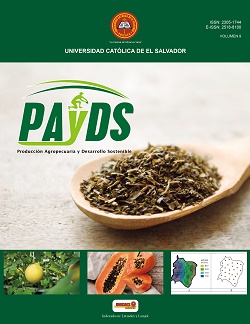Production of melon (Cucumis melo L.) Cantaloupe in greenhouse: correlation between planting density and yield variables
DOI:
https://doi.org/10.5377/payds.v9i0.11851Keywords:
Number of fruits per square meter, Pearson Correlation, linear regression, total soluble solidsAbstract
Pearson correlations were established in Cantaloupe melon produced under a greenhouse, managed with three types of pruning (one stem; two stems; no pruning), between planting density and the following variables: age at the beginning of harvest, fruit weight, number of fruits per plant and per square meter; yield per plant and per area, firmness of the fruit pulp, and percentage of total soluble solids. The crop was managed with fertigation in coconut fiber substrate. For the three types of pruning, the only Pearson correlation that had statistical significance (p ≤ 0.05) was between the sowing density and the percentage of total soluble solids (r = –0.75 **), in which case the regression was obtained linear. For the treatments without pruning and with two-stem pruning, significant correlations were also obtained between planting density and total number of fruits per square meter (r = 0.59 * and 0.73 **); total yield (r = 0.63 * and 0.75 **); and commercial yield (r = 0.57 * and 0.71 **). For the treatment without pruning, a significant correlation was obtained between the planting density and the number of commercial fruits per square meter (r = 0.67 *). It is concluded that, in Cantaloupe melon managed without pruning, the use of a higher planting density caused an increase in the number of fruits (total and commercial) per area, and in the total and commercial yield, although the percentage of total soluble solids
Downloads
620
Downloads
Published
How to Cite
Issue
Section
License
© Producción Agropecuaria y Desarrollo Sostenible
Copyright of the articles is transferred to the journal Producción Agropecuaria y Desarrollo Sostenible
As a user of this journal, you have:
- Open access to consult the information contained in this issue
- Permission to copy, distribute, display, perform or combine past practices in the use of information, provided it is strictly non-profit.
This journal uses a CC BY-NC license





